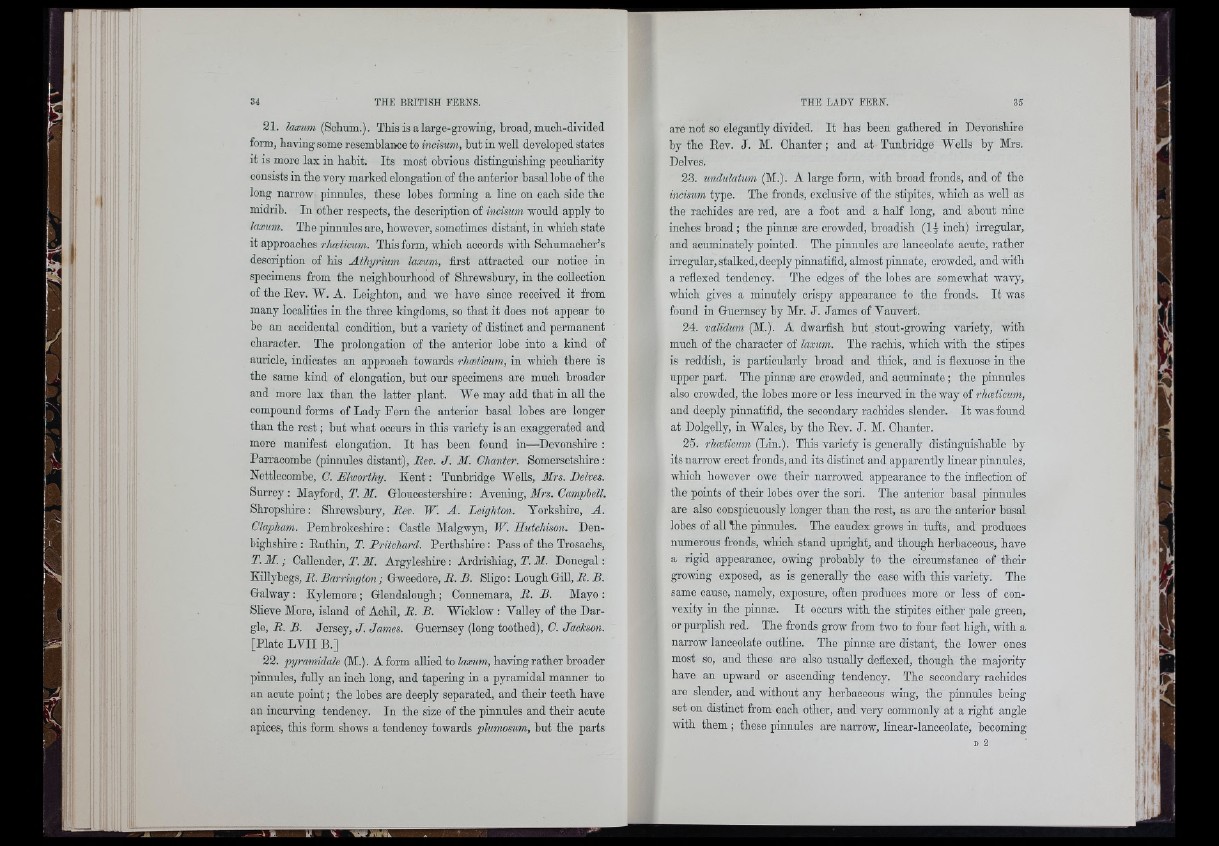
S4 THE BRITISH FERNS.
21. laxt/m (Schmn.). This is a large-growing, broad, muoli-dmded
form, having some resemblance to incisum; but in well developed states
it is more lax in habit. Its most obvious distinguisbing peculiarity
consists in tbe very marked elongation of the anterior basal lobe of the
long narrow pinnules, these lobes forming a line on each side the
midrib. In other respects, the description of incisum would apply to
laxum. The pinnules are, however, sometimes distant, in which state
it approaches rhæticum. This form, which accords with Schumacher’s
description of his Athyrium laxum, first attracted our notice in
specimens from the neighbourhood of Shrewsbury, in the collection
of the Eev. W. A. Leighton, and we have since received it from
many localities in the three kingdoms, so that it does not appear to
be an accidental condition, but a variety of distinct and permanent
obaracter. The prolongation of the anterior lobe into a kind of
auricle, indicates an approach towards rhæticum, in which there is
the same Idnd of elongation, but our specimens are much broader
and more lax than the latter plant. We may add that in all the
compound forms of Lady Fern the anterior basal lobes are longer
than the rest ; hut what occurs in this variety is an exaggerated and
more manifest elongation. It has been found in—Devonshire :
Parraoombe (pinnules distant). Rev. J. M. Chanter. Somersetshire ;
Nettlecombe, G. Elworthy. Kent : Tunbridge Wells, Mrs. Delves.
Surrey : Mayford, T. M. Gloucestershire : Avening, Mrs. Camphell.
Shropshire : Shrewsbury, Rev. TV. A. Leighton. Yorkshire, A.
Clapham. Pembrokeshire : Castle Malgwyn, W. Hutchison. Denbighshire
: Euthin, T. Pritchard. Perthshire : Pass of the Trosaohs,
T. M. ; Callender, T. M. Argyleshire : Ardrishiag, T. M. Donegal :
Killybegs, R. Barrington ; Gweedore, R. B. Sligo : Lough Gill, R. B.
Galway : Kylemore ; Glendalough ; Connemara, B. B. Mayo ;
Shove More, island of Achil, R. B. Wicklow : Valley of the Dar-
gle, R. B. Jersey, J. James. Guernsey (long toothed), C. Jackson.
[Plate LVII B.]
22. pyramidale (M.). A form allied to having rather broader
pinnules, fuhy an inch long, and tapering in a pyramidal manner to
an acute point ; the lobes are deeply separated, and their teeth have
an incurving tendency. In the size of the pinnules and their acute
apices, this form shows a tendency towards plumosum, but the parts
THE LADY FERN. 35
are not so elegantly divided. It has been gathered in Devonshire
by the Eev. J. M. Chanter ; and at Tunbridge Wells by Mrs.
Delves.
23. undulatum (M.). A large form, with broad fronds, and of tbe
incisum type. The fronds, exclusive of the stipites, which as well as
the rachides are red, are a foot and a half long, and about nine
inches broad ; the pinnæ are crowded, broadish (1 j inch) irregular,
and aouminately pointed. The pinnules are lanceolate acute, rather
irregular, staUrod, deeply pinnatifid, almost pinnate, crowded, and vith
a refloxed tendency. The edges of the lobes are somewhat wavy,
which gives a minutely crispy appearance to the fronds. It was
found in Guernsey by Mr. J. James of Vauvert.
24. validim (M.). A dwarfish hut stout-growing variety, with
much of the character of laxum. The raohis, which with the stipes
is reddish, is particularly broad and thick, and is flexuoso in the
upper part. The pinnæ are crowded, and acuminate ; the pinnules
also crowded, the lobes more or less incurved in tbe way of rhætiemn,
and deeply pinnatifid, tbe secondary rachides slender. It was found
at Dolgolly, in Wales, by tbe Eev. J. M. Chanter.
25. rhæticum (Lin.). This variety is generally distinguishable by
its narrow erect fronds, and its distinct aud apparently linear pinnules,
wHcb however owe their narrowed appearance to the inflection of
the points of their lobes over tbe sori. The anterior basal pinnules
are also conspicuously longer than the rest, as are the anterior basal
lobes of aUIhe pinnules. The caudex grows in tufts, and produces
numerous fronds, which stand upright, and though herbaceous, have
a rigid appearance, owing probably to the circumstance of their
growing exposed, as is generally the case with this variety. The
same cause, namely, exposure, often produces more or less of convexity
in the pinnæ. It occurs with the stipites either pale green,
or purplish red. The fronds grow from two to four feet high, with a
narrow lanceolate outline. The pinnæ are distant, the lower ones
most so, and these are also usually deflexed, though the majority
have an upward or ascending tendency. The secondary rachides
are slender, and without any herbaceous wing, the pinnules being
set on distinct from each other, and very commonly at a right angle
with them ; these pinnules are narrow, linear-lanceolate, beooming
J) 2
"I